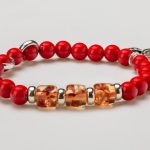Ceramic beads have become increasingly popular in jewelry making due to their unique aesthetic appeal and versatility. However, one common concern that arises is their durability and whether they break easily in normal jewelry wear. In this article, we will delve into the world of ceramic beads, exploring their history, popularity, and the factors affecting their breakage in jewelry.
Ceramic beads have a rich history dating back thousands of years, with evidence of their use in ancient civilizations for adornment. The appeal of ceramic beads lies in their ability to be handcrafted into an array of shapes, sizes, and colors, allowing for endless creative possibilities in jewelry design. Their natural earthy appearance adds a rustic charm to jewelry pieces while also offering a lightweight alternative to traditional metal or glass beads.
When it comes to durability, understanding the composition and structure of ceramic beads is essential. Ceramic beads are made from various types of clay that are fired at high temperatures to achieve hardness. Despite their sturdy construction, factors such as impact, pressure, and heat can contribute to breakage when worn as jewelry. In the following sections, we will explore these factors in detail and provide insights into testing methods used to determine the strength of ceramic beads.
Understanding the Durability of Ceramic Beads
Ceramic beads have gained popularity in recent years for their unique and artistic appeal in jewelry making. However, one common question that arises is, “Do ceramic beads break easily in normal jewelry wear?” To better understand the durability of ceramic beads, it is essential to delve into their composition and structure, as well as how they compare to other types of beads in terms of durability.
The composition of ceramic beads plays a significant role in their durability. Unlike glass or plastic beads, ceramic beads are made from natural materials such as clay that are fired at high temperatures to create a hard and dense surface. This process makes ceramic beads inherently strong and resistant to wear and tear. Additionally, their density and solid structure make them less prone to cracking or breaking when subjected to typical daily activities.
In comparison to other types of beads, such as glass or plastic, ceramic beads are generally more durable due to their composition and manufacturing process. While glass and plastic beads may be susceptible to scratches, chips, or cracks over time, ceramic beads tend to hold up better under normal jewelry wear conditions. However, it is important to note that despite their durability, all types of jewelry are subject to potential damage if not properly cared for.
| Composition | Durability |
|---|---|
| Ceramic Beads | Dense and solid structure makes them less prone to breaking |
| Glass Beads | May be susceptible to scratches, chips, or cracks over time |
| Plastic Beads | Can also experience wear and tear over time |
Factors Affecting the Breakage of Ceramic Beads
Ceramic beads are a popular choice in jewelry making due to their unique look and versatility. However, one common concern among jewelry makers and wearers is whether ceramic beads break easily in normal jewelry wear. Understanding the various factors that can contribute to the breakage of ceramic beads is essential in addressing this concern.
One factor that can lead to the breakage of ceramic beads in jewelry is impact. Whether it’s accidentally knocking your bracelet against a hard surface or dropping your necklace, the impact can cause the ceramic beads to chip or crack. Additionally, pressure from everyday activities such as typing on a keyboard or using hand tools can also put stress on the beads, potentially leading to breakage.
Another important consideration is heat. Ceramic beads may be sensitive to extreme temperatures, so exposure to high heat (such as leaving your jewelry in a hot car) or sudden changes in temperature can result in thermal shock, causing the beads to crack or shatter.
To prevent breakage, it’s crucial to handle ceramic bead jewelry with care and avoid situations where they may be exposed to excessive impact, pressure, or heat. Proper storage and handling techniques can go a long way in preserving the integrity of ceramic bead jewelry.
- Use a soft cloth or felt pouch for storage
- Avoid wearing ceramic bead jewelry during high-impact activities
- Keep away from direct sunlight and extreme heat
By understanding these factors and taking preventative measures, you can enjoy wearing your ceramic bead jewelry without constantly worrying about breakage.
Testing the Strength of Ceramic Beads
When it comes to creating durable and long-lasting jewelry, the strength and durability of the materials used is of utmost importance. This is especially true when working with ceramic beads, as their composition and structure play a crucial role in determining their ability to withstand normal wear and tear. To ensure the quality of ceramic beads in jewelry making, various methods and tests are used to assess their strength and durability.
Some of the common methods used to test the strength of ceramic beads include:
- Tensile Testing: This method involves applying force to a ceramic bead to measure its tensile strength, or its ability to resist breaking under tension.
- Impact Testing: Impact tests are conducted to determine how well a ceramic bead can withstand sudden shocks or impacts without breaking.
- Thermal Shock Testing: Ceramic beads are subjected to rapid temperature changes to assess their resistance to thermal shock, which can cause them to crack or break.
In addition, various non-destructive testing methods such as X-ray diffraction and ultrasonic measurements are also used to analyze the internal structure and flaws within ceramic beads that could contribute to potential breakage. By subjecting ceramic beads to these rigorous tests, jewelry makers can gain insight into their durability and make informed decisions about their use in jewelry pieces.
Tips for Caring for Ceramic Bead Jewelry
Ceramic beads are prized for their unique beauty and versatility, making them a popular choice for jewelry making. However, one common concern among jewelry enthusiasts is whether ceramic beads break easily in normal wear. To ensure the longevity of ceramic bead jewelry, proper care and maintenance are essential. Here are some practical tips and advice on how to care for ceramic bead jewelry to prevent breakage and damage.
Firstly, it is important to handle ceramic bead jewelry with care. While ceramic beads are durable, they can still be susceptible to impact and pressure. Avoid dropping or banging the jewelry against hard surfaces, as this can cause the beads to chip or break. When storing ceramic bead jewelry, wrap it in a soft cloth or pouch to protect it from scratches and impacts that could lead to breakage.
Secondly, exposure to heat can also affect the integrity of ceramic beads. It is advisable to remove ceramic bead jewelry before engaging in activities that involve high temperatures or direct sunlight, such as sunbathing or using hot styling tools. Prolonged exposure to heat can weaken the structure of the beads and increase the risk of breakage.
Finally, regular cleaning and maintenance will help prolong the life of ceramic bead jewelry. Use a soft cloth or brush to gently remove dirt and debris from the surface of the beads. Avoid using harsh chemicals or abrasive cleaners, as these can damage the finish of the beads. Additionally, it is recommended to store ceramic bead jewelry separately from other pieces to prevent scratching or tangling.
Overall, with proper handling and care, ceramic bead jewelry can remain beautiful and intact for years to come.
| Tips for Caring for Ceramic Bead Jewelry | Data |
|---|---|
| Handle with care: Avoid dropping or banging against hard surfaces | Exposure to heat: Remove before high-temperature activities |
| Regular cleaning: Gently remove dirt with a soft cloth | Store separately: Prevent scratching or tangling with other pieces |
Pros and Cons of Using Ceramic Beads in Jewelry Making
Ceramic beads are a popular choice for jewelry making due to their unique and eye-catching appearance. Their use in jewelry can be traced back to ancient civilizations, where they were prized for their vibrant colors and intricate designs. Today, ceramic beads continue to be a favorite among jewelry makers and wearers alike for their versatility and artistic appeal.
Advantages of Using Ceramic Beads
One of the main advantages of using ceramic beads in jewelry making is their aesthetic appeal. These beads come in a wide range of colors, patterns, and shapes, allowing for endless creativity and design possibilities. Additionally, ceramic beads are lightweight, making them comfortable to wear for extended periods. They are also hypoallergenic, making them an ideal choice for individuals with sensitive skin who may react to other metals or materials commonly used in jewelry.
Disadvantages of Using Ceramic Beads
Despite their many advantages, ceramic beads do have some drawbacks that should be considered. One of the primary concerns when it comes to using ceramic beads in jewelry is their breakage potential. While durable, ceramic beads can still break under certain conditions such as impact, pressure, or exposure to heat. This fragility can make them less suitable for everyday wear or pieces that will be subject to a lot of movement.
Breakage Potential
The question “do ceramic beads break easily in normal jewelry wear” is a valid one as they can indeed be more prone to breakage than other types of beads. Normal wear and tear from daily activities such as typing on a keyboard or cooking can put stress on ceramic bead jewelry. In addition, accidental bumps or impacts against hard surfaces can also result in the breakage of these delicate beads.
Alternative Materials for Durable Jewelry
Ceramic beads are a popular choice for jewelry making due to their unique appearance and versatility. However, concerns about their durability and potential for breakage in normal wear have led many jewelry makers and wearers to seek out alternative materials that offer greater strength and resilience. Fortunately, there are several alternative materials available that can be used in jewelry making to create durable and long-lasting pieces.
Metals
One of the most popular alternatives to ceramic beads in jewelry making is the use of metals such as stainless steel, sterling silver, and titanium. These metals are known for their durability and resistance to tarnishing, making them an excellent choice for creating sturdy and long-lasting jewelry pieces. Additionally, metals can be easily manipulated into various shapes and designs, offering a versatile alternative to ceramic beads.
Gemstones
Gemstones are another excellent alternative to ceramic beads for those concerned about breakage. Gemstones come in a wide variety of colors, shapes, and sizes, allowing for endless design possibilities. Common durable gemstones used in jewelry making include diamonds, sapphires, rubies, and emeralds, all of which are known for their hardness and resistance to wear.
Resin or Acrylic
For those seeking a lightweight yet durable alternative to ceramic beads, resin or acrylic beads are an excellent choice. These materials can be molded into various shapes and colors, offering a similar aesthetic appeal to ceramic beads while providing greater resilience against breakage. Resin and acrylic beads also tend to be more affordable than traditional gemstones or metals.
By exploring these alternative materials for durable jewelry making, individuals can create beautiful pieces that not only withstand normal wear but also provide long-lasting enjoyment. Whether it’s the strength of metals, the timelessness of gemstones, or the versatility of resin/acrylic beads – there are numerous options available for those looking to move away from ceramic beads in their creations.
Real-Life Experiences
In conclusion, the durability of ceramic beads in jewelry wear is a topic that has sparked much debate and discussion among jewelry makers and wearers. While ceramic beads are known for their unique beauty and versatility, there is also concern about their potential for breakage in normal jewelry wear. Understanding the factors that can contribute to breakage, such as impact, pressure, and heat, is important for both jewelry makers and wearers.
Testing the strength of ceramic beads through various methods and tests can provide valuable insights into their durability, allowing for informed decisions when it comes to using them in jewelry making. Additionally, proper care and maintenance of ceramic bead jewelry is crucial in preventing breakage and damage over time. By following practical tips on caring for ceramic bead jewelry, such as avoiding exposure to extreme temperatures or harsh chemicals, wearers can prolong the life of their pieces.
As with any material used in jewelry making, there are both pros and cons to using ceramic beads. While they may be more prone to breakage compared to other beads like glass or metal, they offer a distinct aesthetic appeal that many find irresistible.
When considering alternative materials for durable jewelry making, it’s important to weigh the advantages and disadvantages based on individual preferences and needs. Real-life experiences from both jewelry makers and wearers can also provide valuable insights into the longevity of ceramic bead jewelry over time.
Frequently Asked Questions
Are Ceramic Beads Fragile?
Ceramic beads can be fragile, especially if they are thin or have intricate designs. They may chip or break if dropped or mishandled, so it’s important to handle them with care.
How Long Do Ceramic Beads Last?
The lifespan of ceramic beads can vary depending on their quality and how well they are cared for. Generally, high-quality ceramic beads can last for many years if they are not subjected to rough treatment or harsh conditions.
How Do Ceramic Beads Work?
Ceramic beads work by providing a durable and decorative form of embellishment for jewelry, clothing, and crafts. They come in various shapes, sizes, and colors, making them versatile for different design purposes. Additionally, ceramic beads can also be used in pottery and other art projects to add texture, color, and visual interest.

Welcome to my jewelry blog! My name is Sarah and I am the owner of this blog.
I love making jewelry and sharing my creations with others.
So whether you’re someone who loves wearing jewelry yourself or simply enjoys learning about it, be sure to check out my blog for insightful posts on everything related to this exciting topic!





